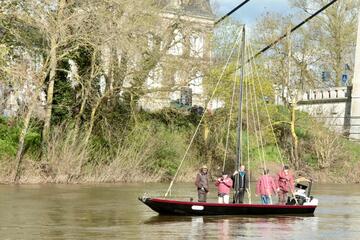
09/04/2024
[Fr] L'Alose, une plate de Loire remise à l'eau à Chalonnes-sur-Loire
Samedi 30 mars, le quartier des mariniers était en liesse. Ils étaient nombreux à avoir répondu à l’invitation des Chalandoux du 5ᵉ Vent pour accompagner...
Published on 03 May 2011 - Updated 12 July 2013
Cet article date d'il y a plus de 12 ans
170 Loire Valley stakeholders, mainly local councillors and council staff, government officials (from DREAL, the French environment agency and DDT, the department for local communities) and members of local organisations took part in two sessions of this UNESCO workshop on the landscape, organised by the Mission Val de Loire: two opportunities to gather information, share experiences and discuss. The next workshop, to discuss the fleets and ports of the Loire, is organised by the regional municipality of Chaumont and will take place at Fontevraud Abbey.
This series of UNESCO landscape workshops, hosted by the Mission Val de Loire, coincides with the establishment of a Site Management Plan: the aim is share information and exchange experiences of best practice, topic by topic.
The morning session will be devoted to reviewing some basic ideas: the aims of the management plan for the banks of the Loire, the characteristics of the Loire’s navigable landscapes, and the management of public waterways. In the afternoon, there will be presentation of case studies and local experiences.
Also: see resource documents
The Government’s public river management objectives are: safety, biodiversity and landscapes. Safety for communities at risk of flooding is the highest priority, but this is in no way conflicts with the other two aims: the devegetation of banks for safety reasons both creates an ecosystem that benefits the development of varied fauna and flora as well as opening out sightlines along the Loire. Government officials have, besides, stated their willingness to work more closely with partnerships and local riverside communities to maintain the riverbed (in developing agreements about changes of usage).
Michel Bacchi, head of the “Rive” consultancy, after having summarised the principles of fluvial dynamics and the way the Loire has changed over the past 50 years (drop in the low water level, revegetation, etc.) then went on to explain the principles of maintaining and developing the riverside:
He reminded the audience of the sensitive nature of the riverside environment and the care required in making changes to the riverbed because of the impacts on its hydraulic behaviour and on fauna and flora, and not simply moving a problem upstream or downstream.
Also, during each of the sessions, there were presentations of two original case studies:
Bien reçu !
Nous vous répondrons prochainement.
L’équipe de la Mission Val de Loire.